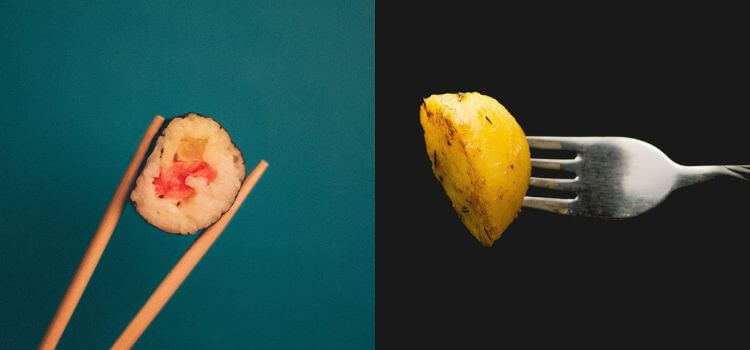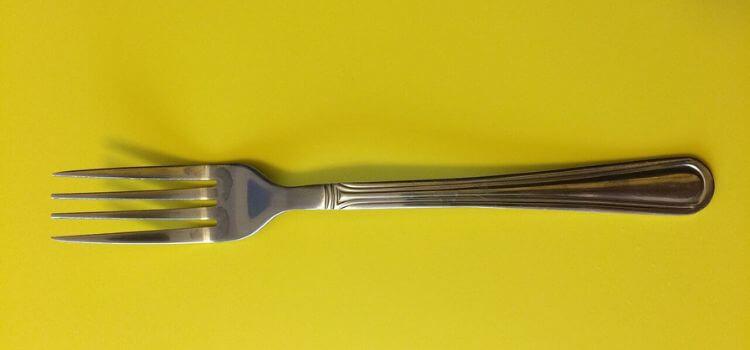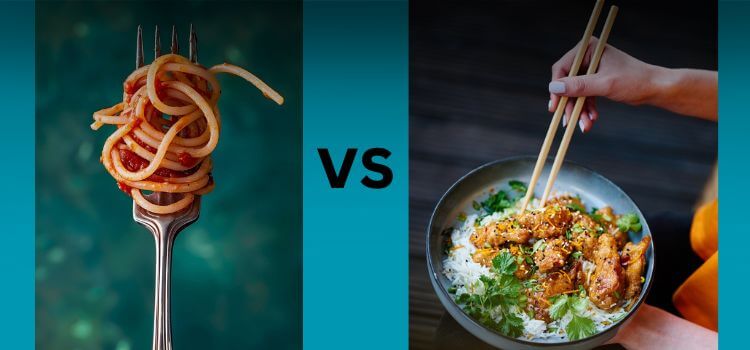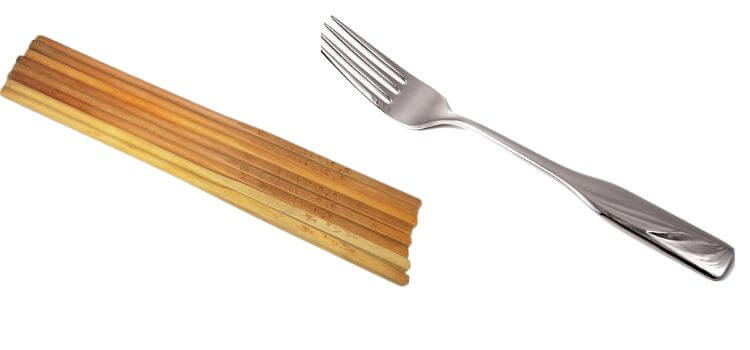
Chopsticks and forks are two of the most common utensils used around the world for eating. While chopsticks are popular in many Asian countries, forks are widely used in Western countries.
Understanding the differences between these two utensils can help us appreciate the cultural and practical reasons behind their use. In this article, we will explore the history, cultural significance, usability, and environmental impact of chopsticks and forks to see how they compare.
Culinary Showdown: Fork Versus Chopsticks
The battle between fork and chopsticks is timeless. Each has its unique charm and history. This blog dives into their significance and symbolism.
Historical Significance
Both utensils have rich histories. Forks date back to ancient Rome. They were used by the wealthy. Chopsticks originated in China around 1200 B.C. They were initially cooking tools.
| Utensil | Origin | Time Period |
|---|---|---|
| Fork | Ancient Rome | 4th century |
| Chopsticks | China | 1200 B.C. |
Cultural Symbolism
Chopsticks are more than utensils. They are symbols of balance and harmony. They represent respect in many Asian cultures.
Forks, on the other hand, symbolize individualism. In Western cultures, eating with a fork is a sign of sophistication.
Both utensils carry deep meanings. They mirror the values of the cultures they belong to.
The Fork: A Western Dining Staple

The fork has been a important part of Western dining for centuries. Its unique design and practical use make it a favorite at dinner tables. This section delves into the fork’s evolution, its design, and how to use it correctly.
Evolution And Design
The fork originated in the Middle East and later spread to Europe. Initially, it had only two tines. Over time, it evolved to have four tines, making it more versatile.
Modern forks come in various shapes and sizes. The most common types are the dinner fork, salad fork, and dessert fork. Each one serves a specific purpose. For example, the salad fork is shorter and has wider tines.
Materials used to create forks have changed over time. In the past, early forks were crafted from wood or bone. Today, most forks are made of stainless steel, which is durable and easy to clean.
Etiquette And Techniques
Using a fork correctly is essential in Western dining. One common technique is the “Continental” style. In this style, the fork is gripped in the left hand with the tines pointing downward.
Another popular method is the “American” style. Here, the fork is held in the right hand, tines facing up. This style often involves switching the fork between hands.
Knowing how to use a fork properly shows good manners. It also makes eating more efficient. For example, use the side of the fork to cut soft foods.
| Type of Fork | Use |
|---|---|
| Dinner Fork | Main courses |
| Salad Fork | Salads and appetizers |
| Dessert Fork | Desserts and fruits |
In formal settings, place the fork on the left side of the plate. Ensure the tines are facing up. This small detail can make a big difference in etiquette.
Forks have a long history and play a vital role in Western dining. Understanding their evolution, design, and proper use can enhance your dining experience.
Chopsticks: An Eastern Tradition

Chopsticks are an Improtan part of Asian dining culture. They are more than just utensils. These slender sticks have a rich history and cultural significance. They symbolize tradition and are a testament to the ingenuity of Eastern civilizations.
Origins And Varieties
The origins of chopsticks trace back to ancient China. They date back over 5,000 years. Initially, they were used for cooking. Later, they became a dining tool. Different regions have unique styles:
- Chinese chopsticks: Long and rectangular.
- Japanese chopsticks: Shorter and pointed.
- Korean chopsticks: Made of metal, flat and square.
Proper Usage And Mastery
Using chopsticks requires practice and patience. Here’s a simple guide:
- Hold one chopstick like a pencil.
- Place the second chopstick under the first.
- Use your thumb to stabilize both
Mastering chopsticks shows respect for Asian traditions. It also enhances your dining experience.
| Country | Material | Length | Tip |
|---|---|---|---|
| China | Bamboo/Wood | Long | Blunt |
| Japan | Wood/Lacquer | Short | Pointed |
| Korea | Metal | Medium | Flat |
Material Matters: From Wood To Metal
Choosing between forks and chopsticks often involves more than just tradition. The material from which these utensils are made plays a significant role. This affects not only their usability but also their environmental impact and aesthetics. Let’s dive into how different materials like wood and metal stand up in this age-old debate.
Environmental Impact
Wooden chopsticks are often made from bamboo or other sustainable sources. These materials are biodegradable and eco-friendly. On the other hand, metal forks are usually made from stainless steel. While durable, their production involves mining and energy-intensive processes.
- Wooden chopsticks are often disposable, leading to waste.
- Metal forks can be reused, reducing waste over time.
Choosing reusable wooden chopsticks or metal forks can help reduce environmental impact. Reusable utensils are a better choice for the planet.
Durability And Aesthetics
Metal forks are known for their durability. They can last for many years. Wooden chopsticks may wear out more quickly. Frequent use can lead to splintering or breakage.
| Material | Durability | Aesthetics |
|---|---|---|
| Wood | Low | Natural, rustic look |
| Metal | High | Sleek, modern appearance |
In terms of aesthetics, wooden chopsticks offer a natural, rustic look. Metal forks provide a sleek, modern appearance. The choice between the two often depends on personal preference and the dining setting.
Food Types: The Battle Of Versatility

Forks and chopsticks have unique strengths for various foods. Each utensil brings its own versatility to the table. Let’s explore their capabilities with different food types.
Suitability For Various Cuisines
Forks are excellent for Western cuisines. They handle dishes like pasta, steak, and salads with ease.
- Pasta: Twirl spaghetti effortlessly.
- Steak: Cut and pierce meat slices.
- Salad: Spear veggies and fruits.
Chopsticks shine in Asian cuisines. They are perfect for sushi, noodles, and rice dishes.
- Sushi: Pick up rolls without squishing.
- Noodles: Slurp ramen or udon smoothly.
- Rice: Scoop grains delicately.
Efficiency In Handling Different
Forks are efficient with firm and dense textures. They pierce meat, veggies, and fruits effectively
| Food Type | Fork Efficiency |
|---|---|
| Meat | High |
| Vegetables | High |
| Fruits | Medium |
Chopsticks excel with delicate and slippery textures. They grasp noodles, tofu, and dumplings well.
| Food Type | Chopstick Efficiency |
|---|---|
| Noodles | High |
| Tofu | Medium |
| Dumplings | High |
Both utensils have their unique strengths and serve different culinary purposes. Choose based on your dish and dining experience.
Health And Hygiene: Eating Utensils Scrutinized
Eating utensils play a crucial role in our daily lives. They impact our health and hygiene significantly. Forks and chopsticks are the most common utensils worldwide. But how do they differ in terms of health and hygiene? Let’s explore the nuances of each.
Ergonomics And Digestion
Ergonomics matter when it comes to eating utensils. Forks are easy to use for most people. They require minimal coordination. This makes them perfect for both kids and seniors
Chopsticks, on the other hand, require a certain skill level. Using chopsticks can improve fine motor skills. This can be beneficial for hand-eye coordination.
Digestion is important. Using forks makes us eat fast, which can cause overeating and indigestion. Chopsticks make us eat slower, helping with better digestion and controlling portions.
Cleanliness And Maintenance
Cleanliness is crucial for any eating utensil. Forks are generally easier to clean. They have a simple design with fewer crevices. This helps prevent food from getting stuck.
Chopsticks, especially wooden ones, require more care. They can absorb food particles and bacteria. Regular cleaning and drying are essential.
| Factor | Fork | Chopsticks |
|---|---|---|
| Ease of Use | High | Moderate |
| Cleanliness | Easy to Clean | Requires More Care |
| Digestion | Can Lead to Overeating | Promotes Slower Eating |
| Maintenance | Low | High for Wooden |
Social Implications: Dining Etiquette Across Cultures
Dining etiquette varies across the world. Using forks or chopsticks can reflect deep cultural norms. Understanding these can help you navigate social situations better.
Adapting To Customs
In the West, forks are common at the dining table. In East Asia, chopsticks are the norm. Adapting to these customs shows respect and understanding.
When visiting a new country, learn the local dining etiquette. This can prevent embarrassing mistakes. Use a fork in Europe and chopsticks in Japan.
Locals appreciate your effort to follow their customs. It shows you value their culture.
Utensils As Status Symbols
In some cultures, dining utensils symbolize social status. In ancient China, chopsticks were made of gold for the wealthy. In Europe, silverware indicated high social rank.
| Culture | Utensil | Material |
|---|---|---|
| China | Chopsticks | Gold |
| Europe | Fork | Silver |
The Modern Table: Fusion And Adaptation
The modern dining table is a melting pot of cultures. It showcases the fusion of different eating tools. Both forks and chopsticks have found their places. These tools reflect the globalization of dining habits. People are open to adapting and experimenting with new utensils.
Globalization Of Eating Tools
Global travel and migration have changed dining habits. People now use both forks and chopsticks. This change has led to a blend of dining cultures. In many restaurants, you see both utensils on the table.
Food lovers enjoy trying new cuisines. They learn to use different eating tools. This mix enriches the dining experience. It also makes people feel connected to other cultures.
Innovations And Future Trends
Innovations in eating tools are on the rise. New designs aim to combine forks and chopsticks. These hybrid tools are user-friendly and fun to use.
Here are some examples:
- Chork: A mix of chopsticks and a fork.
- ForkChop: A fork on one end, chopsticks on the other.
Future trends point to more such hybrids. These tools help in making dining more inclusive. They bring a sense of unity at the table.
Personal Preference Or Cultural Heritage: What Guides Our Choice?
Choosing between a fork and chopsticks can be intriguing. This choice can reflect personal preference or cultural heritage. Some people are born into cultures that use chopsticks daily. Others grow up using forks at every meal. The reasons behind these preferences can be deep-rooted and fascinating.
Identity And Dining Choices
Our dining tools often reflect our identity. For many, chopsticks symbolize a connection to Asian heritage. Using chopsticks can feel like an embrace of cultural traditions. On the other hand, forks are common in Western cultures. They represent convenience and familiarity.
Family traditions play a significant role in these choices. A child raised in an Asian household may naturally prefer chopsticks. In contrast, those from Western families might find forks easier to use.
The Influence Of Travel And Dining Experiences
Traveling can broaden our culinary horizons. Many people discover new dining tools while traveling. They might try chopsticks in Japan or a fork in Italy. These experiences can influence their preferences.
- Exposure to different cultures can shape dining habits.
- Trying new foods often involves using new tools.
- Adapting to local customs can be a memorable experience.
Dining experiences in restaurants can also impact our choices. An authentic Chinese restaurant might provide chopsticks. A traditional French bistro will offer forks. These experiences can leave lasting impressions.
Ultimately, the choice between a fork and chopsticks can be guided by many factors. Personal preference, cultural heritage, and travel experiences all play a role. Understanding these influences can enrich our dining experiences.
The Verdict: Can There Be A Clear Winner?

Forks and chopsticks are popular dining tools. Both have their unique uses. People often debate which is better. This section explores if there can be a clear winner.
The Role Of Personal Comfort
Personal comfort plays a significant role in this debate. Some find forks easier to use. Others prefer the control chopsticks offer. Comfort varies from person to person.
Many people grow up using forks. They find them straightforward and easy. On the other hand, chopsticks require practice and skill. Those who master them find a unique joy in using them.
Comfort can also depend on the food type. Eating noodles with chopsticks feels natural to many. Cutting meat with a fork and knife feels right to others. Each tool has its strengths.
Embracing Diversity In Dining
Diverse dining tools show cultural richness. Forks are common in Western cultures. Chopsticks are prevalent in many Asian countries. Using both can enhance your dining experience.
Trying new tools can be fun. It can also be a learning experience. You understand and appreciate different cultures. This makes dining a more enriching activity.
Restaurants also embrace this diversity. Many offer both forks and chopsticks. This caters to a wider range of diners. It ensures everyone enjoys their meal comfortably.
Here’s a simple table comparing forks and chopsticks:
| Aspect | Forks | Chopsticks |
| Ease of Use | Easy for most people | Requires practice |
| Types of Food | Good for solid foods | Good for noodles and small pieces |
| Cultural Significance | Western cultures | Asian cultures |
Embrace both tools. Enjoy a more diverse dining experience. This enriches your meals and broadens your cultural knowledge.
Frequently Asked Questions
What Are The Main Differences Between Forks And Chopsticks?
Forks have prongs, making them easy for piercing food. Chopsticks are sticks, ideal for gripping and picking up food.
Which Is Easier To Use: Forks Or Chopsticks?
Forks are generally easier for beginners. Chopsticks require practice but offer a unique dining experience.
Are Chopsticks Healthier Than Forks?
Chopsticks can promote slower eating, which aids digestion. Forks don’t affect eating speed as much.
Can I Use Chopsticks For All Foods?
Chopsticks work best with Asian cuisine and small pieces. They aren’t ideal for soups or steaks.
Conclusion
Choosing between forks and chopsticks depends on your preference and the cuisine. Forks offer ease and versatility. Chopsticks provide cultural richness and finesse. Both have unique advantages. Embrace both tools to enhance your dining experiences. Ultimately, the best choice is the one that suits your meal and comfort level.
Leave a Reply